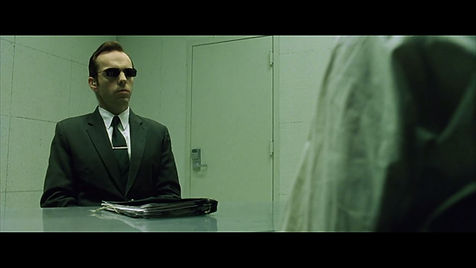About the Author

This website represents the culmination of my time at the University of Texas at Austin receiving my Masters in Media Studies.
I first began to take an interest in machine-human interactions and relationships in Dr. Sharon Strover's "Communication, Technology, and Culture" class, where I was first introduced to the digital influencer Lil Miquela. Miquela was the start of my thinking about the ways that we integrate machines and technology into our daily lives. In following this line of enquiry, I found myself contemplating the way that in taking a recuperative stance toward technology, and in looking at our images of machines and tech through a queer lens, can reveal new modes of being in the world. I found myself transfixed by the ways that these creations are frequently the backdrop that allow humans a way to imagine a different world and a different self. More often than not, these imaginings take on a distinctly counter-hegemonic sensibility.
Halfway through “Communication, Technology, and Culture” (Spring 2020), the COVID-19 pandemic forced us into remote online courses. I’m writing this section on the one-year anniversary of the World Health Organization declaring a worldwide pandemic. Since then, I’ve completed the majority of my Masters remotely.
Bentham's 1791 sketches of the panopticon.
Digital construction of the panopticon by Henri Weijo.
(Re)Envisioning the Panopticon
Expanding past Bentham's rigid model
The machines treat each person in the Matrix as an individual, hyper-monitored for the most efficient output of energy to be harvested by the machines. This type of top-down control and hyper surveillance of movement corresponds with Foucault’s understanding of modern (bio)power. It is a disservice to write about the Matrix and not reference Foucault’s thoughts on Bentham’s panopticon. The Matrix is an:
architecture that [was] no longer built to be seen...or to observe the external space (the geometry of fortresses), but to permit an internal, articulated and detailed control-to render visible those who are inside it; in more general terms, an architecture that would operate to transform individuals: to act on those it shelters, to provide a hold on their conduct, to carry the effects of power right to them, to make it possible to know them, to alter them” (172).
Disicipline and Punish, Foucault
The model of the panopticon is frequently used to theorize intersections of power and surveillance. Yet, it doesn’t take into account the subjects’ responses and oppositional actions to being surveilled. The panoptic model discounts the manner that, stated by Kevin D. Haggerty in “Tear Down the Walls: On Demolishing the Panopticon,” “watching others and exposing oneself can...occasionally [be] part of larger processes of identify [sic] formation” (28). Neo’s response to the Matrix’s surveillance ties in with the sense of empowerment he experiences from revealing himself and combating the Matrix. This empowerment is integral to how Neo constructs his identity. Neo’s “oppositional gaze” (hooks) towards Agent Smith, and the machines as a whole, is a method to conceive of the ways that surveillance can be (queerly) countered. Gary Kafer and Daniel Grinberg state in their article “Queer Surveillance”:
Queerness is an animating difference without a fixed referent—a site of nonnormative disruption that accrues to different bodies at different times and in different contexts to name the boundary between security and disposability...Attending to the queerness of surveillance demands a vigilance to the ways in which norms mutate across sites of control...(595)
In short, Kafer and Grinberg assert that queerness as an identity and a disruption is something mobile. It resists being characterized in the same manner every time. As surveillance operates on individualizing subjects based on general (and heteronormative) categories like gender representation, employment, and citizenship, queer subjects are frequently a glitch in the system.
Fluid Surveillance
This “glitch in the system” is evident in the key moments throughout the film where Neo and the Resistance reveal themselves to the machines (rescuing Morpheus, the final fight between Agent Smith and Neo) and key moments where they opt to conceal themselves from the machines (Neo escaping from the Matrix, hiding aboard the Nebuchadnezzar). This slipping between revelation and concealment is in opposition to the panoptic model of rigid one-way viewing, revealing it to be something much more irregular and unstructured. In The Culture of Surveillance, David Lyon contends that “surveillance culture is multifaceted, complicated, fluid, and rather unpredictable” (10). This multifacetedness and fluidity is continually emphasized with the introduction of new technologies, as they “[shift] the focus from fixed to fluid surveillance, from hardware to software” (21). Thinking about the panoptic model in this fashion, with a focus on “fluid surveillance” accounts for how both visibility and invisibility can serve strategic purposes, frequently tied into survival.
Other moments of queer revelation can be see in David France’s 2020 documentary, Welcome to Chechnya. Click here to learn about the techniques used by queer Chechen refugees and activists to negotiate revealment/concealment in respects to the Republic..
Click here to read about the moment refugee “Grisha” reveals his face and name (Maxim) to the Chechen press to publicly speak out about the atrocities committed against queer Chechens.
Defiantly Looking Back



Neo’s ability to “look back” at the Matrix “ruptures the unidirectional nature of the gaze...and [undermines] the neat distinction between watchers and watched” (Haggerty 29). This sense of defiantly staring back culminates at the end of the film, when Neo is able to move and see as the machines do. He defiantly meets Agent Smith’s gaze in the abandoned apartment building. As Neo looks back and matches Agent Smith’s look, Neo now sees Smith in the green and black flowing code of the Matrix. This is Neo’s apotheosis (in this film) as he is fully aware of himself and his relation to the Matrix and the programs. Set apart from the machines and the other members of the Resistance as having fully assumed his role as “The Chosen One,” Neo’s gaze back at Agent Smith is transformative. Neo’s gaze back at Agent Smith is transformative. It is a direct refusal to be surveilled and categorized—to be made legible—by the systems the machines have been using to surveil and categorize for hundreds of years. His gaze is a recognition that the Matrix is both separate and something internal, something that is constructed within him. In queerly countering the surveillance of the program, Neo is using its methods against their agents and in doing so has become illegible to the system. In literally breaking the mold of the surveilled individual, Neo queerly “exceeds surveillance insofar as surveillance fails to fully reduce ‘the open mesh of possibilities, gaps, overlaps, dissonances and resonances, lapses and excesses of meaning’ into fixed profiles” (Sedgewick qtd in Kafer and Grinberg 598). It is the beginning of the end for Agent Smith and the rest of the machines.
Thinking Onward: What are examples of panoptic surveillance in society today? How do we "look back?"
Tweet your thoughts and include #QueerHMrelations
 Hyperreality and the Matrix |  Constant Discipline in The Matrix |
|---|---|
 Simulation and Simulacra in the Matrix |  Back to the Matrix Entrance Page |